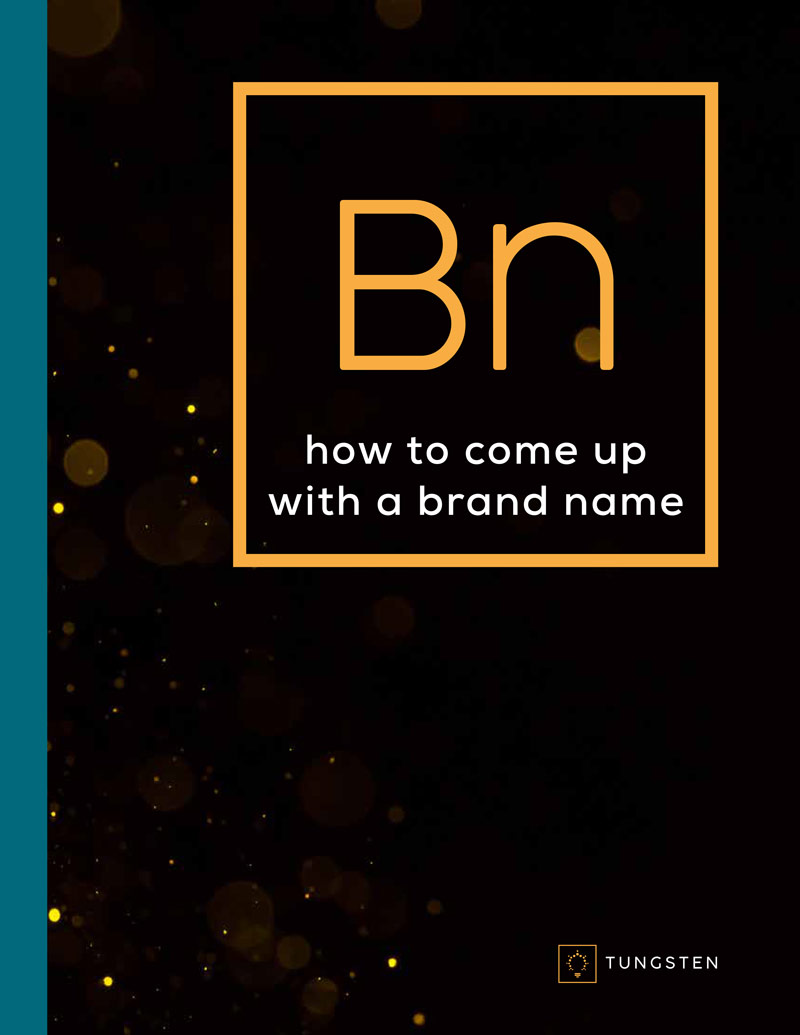Episode 005: Naming a Start-up Company – 5 Steps to Naming Your Business Bright
Brilliant Branding Live Show Archives
Originally aired weekly August 2017 - August 2018 With host Phil Davis
Show Description
"Brilliant Branding" shines the spotlight, and provides valuable insights, into the most common, and frustrating company identity issues facing startups, entrepreneurs, consultants, and even established business owners. Topics address timely issues such as effective naming strategies, smart logo design, tips for trademarking, clear brand messaging, engaging social media and reputation management. We take a deep dive to uncover the "pivot point" of an organization, the "why" behind each business to help build a more clear, cohesive and compelling brand image.
Here at Tungsten, we’re all-too-familiar with the branding needs of a new start-up. In fact, entrepreneurs starting new companies account for more than half of all of Tungsten’s clients. We get it. You’re in a tough position. Budgeting is tight, you probably have a skeleton crew of people running the show, you’re filling multiple roles within the organization, and there’s this incredible sense of urgency. You’re about to do a roll-out, a launch, a trade show, maybe you’re on the verge of landing your first major client… And now you need to appear legitimate. You need instant credibility. You need to pass the “sniff test”. You need a name, a website, a logo, a brand, like… yesterday. Well if this is you, then you’re in luck because today’s Podcast is all about how to name and brand new startup.
Most naming firms will run anywhere from $10,000 on the low side up to $50,000 or so. Ouch! Maybe you’ve got that kind of money, in which case hiring a branding firm is an excellent choice. For those with extravagant budgets, the sky’s the limit. You can hire a large scale branding firm with committees, linguistics researchers, etc. For most new startups, however, paying a branding firm can be a real “budget buster”. This episode is aimed at enabling the do-it-your-selfers to build your own brand.
Start-Up To-Do List
First, you need to know your objectives and criteria. What are you setting out to do in general? A lot of times people reach out to us during this very painful point. At this point, it’s already devolved. They’ve hastily assigned themselves some random, arbitrary name. It’s sort of a filler name. More an obligation than a purposeful statement. A lot of times people pick really random things to name their business after. They often name it after a hobby, some significant experience or location in their life, some story, etc. It’s as if they’re picking lottery numbers. They’ll say things like, “This has my name, my kids birthday, etc.” You’ve got to start with an objective.
These are broken plays. Names that are assembled from some sort of random criteria of yours may bear no significance at all to your customer. Another example of a losing strategy these days is to pick a name that you think will allow for a higher ranking in the Yellow Pages. The Yellow Pages have become increasingly irrelevant over the years and few people look up services this way anymore. Even creating a name for Google optimization is becoming increasingly ineffective. The current market favors real, authentic brands and real authentic messaging.
So it’s time to start asking yourself the important questions needed to determine your brand identity.
Here are a few questions that will help you name your start-up company:
1. What do I want this company name to accomplish?
Your brand name should try and actually accomplish something aside from being a placeholder, a description of your services, or securing a placement in the yellow pages.
2. Do I want to stand out, or blend into the industry?
There is no right answer to this. If you’re in the financial industry, for example, you may actually benefit from not standing out. You may actually want to sound like you belong so that people can easily locate your brand and so that your name sounds older, wiser, and time-tested. On the other hand, maybe you want to stand out. Maybe you’re first in your category or you’re just trying to be disruptive. In this case, you may benefit from making a big bold statement. Just remember that if you go this direction, you’re gonna need to commit to it fully. Want to call yourself “Wizz Pow!”? That’s fine, but you better be dropping into your ads with an orange jumpsuit with confetti and coconut water. In other words, if you want to be outrageous, that’s fine. You just need to own it.
3. Where will the company be in 3 to 5 years?
This first product launch may be all that you can think about. Of course, what you’re doing now is incredibly important. However, you’re going to need to take a step back and consider your greater role and how you will evolve as a company. You need to take a long-term view or else you will get stuck having a name that revolves around your initial product offering. What was once your greatest branding strength can easily become your branding Achilles’ heel.
4. Will the name need to accommodate additional products and services?
Do you plan on selling anything more? Is the product you’re selling now all you will sell? If you plan to sell an entirely different product or service in the next several years, you need to make sure your brand can fit that product or service into itself.
5. If your name could only communicate one thing, what would it be?
It’s easier to be expansive in your brand messaging than it is to be concise. Unfortunately, you have very limited space and time to communicate your message to your customer. Knowing the answer to this question will keep you from creating short-term naming solutions because the temptation to name and brand for the short-term will always be there. Things are changing too quickly to allow yourself to become anchored to one thing or idea. The more you anchor to things, the more they hold you back. Even terminology changes. For example, cell phones were once called mobile phones. Before that, they were called car phones. If these companies had called themselves “XYZ Car Phone” all those years back, their brands would have become increasingly dated and irrelevant just do to evolution and multitude of iterations of a single technology.
6. What is your naming criteria?
Rather than being a list of things that you want your name and brand to do, your naming criteria is a list of things your name and brand has to do.
Here are a few examples of questions that should be included in creating your brand criteria:
-
- Will it pass USPTO? Is it easy to say/ spell?
-
- Is it easy to read?
-
- Is it engaging?
-
- Does it create interest?
-
- Does it provide a platform?
-
- Does it allow you to tell your story?
-
- Is the matching dot com available?
-
- Is it available from a trademark perspective?
-
- Does the name segway into a deeper conversation?
- Does the name communicate your primary core value competition?
-
- Does it communicate the essence of what you do what you do?
7. Who is going to name your company?
You have a few choices here. You can do it yourself, crowdsource, or hire a firm.
Like we said earlier, hiring a firm is the best approach, but it can be costly and the price can easily exceed many normal startup budgets.
Crowd-sourcing your naming and branding can be an affordable alternative to hiring a branding firm. These companies will create custom names, logos, web design, etc. for you. Frozen Lemons and Crowd Spring are a couple of examples of companies that take this approach. They’ll throw lots of names at you and you’ll get legit-looking stuff. The only issue paying for services like these is that they don’t know anything about you or your company. While everything may look and sound really good, it might not fit you.
The pros of naming your company yourself is that you save money. That’s it. The cons are that you will spend a lot of time on it and that you may fall into some of the traps/ missteps of trying to do it yourself. For example, you may brand yourself into a dead end that limits you as you expand years later. You could also end up with a trademark issue or wind up in some sort of legal trouble. Look at branding your own business like doing your own home repairs. It may save you money, but it also comes with the risks inherent in taking on a big project while lacking expertise.
If you’re going to name your own company, try to include just yourself or as few people as possible. Remember that a camel is a horse that was made by the committee. The larger the committee, the more issues you will inevitably have. You may also end-up settling for a name that everyone liked but that nobody absolutely loved. You may end up with the least common denominator. That doesn’t mean you shouldn’t take other people’s input into consideration. You should encourage and Invite input, but that’s it. Take their opinions and ideas into consideration, but at the end of the day limit the number of people that will be in charge of the decision. Don’t feel bad about not including them in the decision. This can actually be a positive for a lot of people. Tell them they won’t have to go to every meeting, every round of naming, every discussion, every vote… most of them will be happy.
Actually naming it
People worry so much that “people aren’t gonna get what we do”. Just write down on a page what you do. “We are a company that does….” On the other side of the page write how. “We offer quality, we offer brilliance, we offer variety, etc.” Maybe you’re about innovation. Maybe you’re about customer service. Maybe you’re about quality. Maybe you’re so all about quality that you’ll refuse to ship a product until you can get it just right; you’ll disappoint the customer before you ship a product that doesn’t meet your standards. If it came down to one thing, what’s most important?
Decide which of these qualities is the most important.
Try this exercise:
Write down the following sentence and fill in the blanks. “Our main goal is to do/provide/offer/ specialize in ______ by doing/serving/ providing ________.”
Here’s an example of that exercise for our company, Tungsten.
“We strive to create clear, compelling, company brand identities by offering insight and clarity into the naming process.”
This is our differentiator. This is our “how”. We used a metaphor. We used Tungsten.
Next, create an inventory list of these words that describe your company and capture what you do.
Now make a 10X10 grid on excel or on a large piece of paper. Start dropping words into horizontally across the top and vertically down the left-hand column. One column will contain prefixes and the other will contain suffixes. Where these rows and columns meet, write in the word combinations. If this doesn’t make any sense to you, look down at the bottom at a few of the resources we’ve provided that help you to fill these out automatically.
Use a thesaurus. Find synonyms and start dropping the words in. Take the word “speed” for example.
Synonyms: Speed, quick, instant, dash, fast flash, pronto presto jiffy, zoom, zap, snap, etc.
You can also use metaphors for speed:
Jet, comet, lightning, blitz, bolt, etc.
You can take it a step further and use some sort of symbolism. How about a speedy animal?
Rabbit, gazelle,cheetah, falcon, eagle…
Now, what are you going to mix in with these? You need words to mix in with your descriptive words. These are like the protein of your company naming. They’re like tofu. These tofu words. absorb the flavor of what’s next to it.
Examples: Point, mark, line, square, block, works, ever… You’ll see these in some company names. It’s their core words like the word “line”.
Priceline. Safeway. Cinemark.
Consider using positive connotation or “evergreen words”. These are words that just sound positive and good and can be mixed and matched to create a name that just sounds great no matter what it is. For example:
Onstar – On sounds good. Star sounds good.
Brighthouse – Bright sounds positive. A bright house sounds even more so.
True Green – True? Good! Green? Yes!
DreamWorks – Dreams sound nice. Dream works? Yes please!
See how these positive words can be mixed together? These make for great brand names. You can also dial it back if you’re afraid someone isn’t going to “get you”. Just mix the two and create a hybrid.
Here are a few examples:
JetBlue – Jet is literal. Blue makes you think of clear blue skies.
CarMax – Cars are what they sell. Max sounds big and expansive. The maximum amount of cars.
Famous footwear – Brand name footwear
Snapchat – “Snap” and “chat”
Instagram – “Instant grams (picture messages)”
You can also include key attributes.
For example, If you’ll always be about speed, economy, value:
Quickbooks
Priceline
Econo Lodge
You can also make unique words by taking some of these root words and “twist them up” by adding a creative ending to it.
For example:
Travelocity – Made up word with travel in it.
Clariscent – Made up word with “clarity” in it (We named this one!)
Experiment with these combinations. By filling out this grid you can start visualizing these names and seeing new possibilities. You’ll see all these combinations spelled out in front of you.
Online domain name resources:
If you’re feeling a little lost, there are several online domain name tools that may help you to find your way. Here are a few:
BlinkDomains.com Remember the 10X10 word list we mentioned earlier? This is an online tool that allows you to create and fill out a naming grid. It also allows you to instantly see if each of these names are available.
LeanDomainSearch.com Lean domain search is similar to Blink Domains, except that it takes your keyword and auto-suggests word optimal word pairings.
USPTO.gov The United States Patent and Trade Office offers a free online tool called Trademark Electronic Search System, or TESS for short. This tool will allow you to search for through a vast database of patents and trademarks. Use this tool to determine whether or not a name you’re interested in is being used by a company in the same or a similar industry. While this tool can’t 100% verify whether or not you’re “in the clear” in terms of avoiding trademark conflicts, it is a great start. This tool will also help you to determine how much what we in the industry call “white space” surrounds your name. That is to say that this tool will help you to see to what extent your name or similar names are already being used and to evaluate how crowded that space is.
TMExpress.com Trademark Express is a great resource to conduct a much more thorough trademark search. Few just a few hundred bucks, this service will extensively search through all sorts of records and databases in order to ensure there aren’t any conflicts involved in using your name, tagline, concept, etc.
At the same time, we want to be clear that we suggest consulting your own legal counsel whenever possible in order to avoid legal issues associated with trademark and copyrights.
That’s it for today’s episode. We hope you’ve enjoyed the information and that it’s helped you to start on your way to naming your own company and building a great brand. As always, stay tuned every week for more brilliant branding tips and tricks from one of the top branding agencies in the world, Tungsten Branding.




